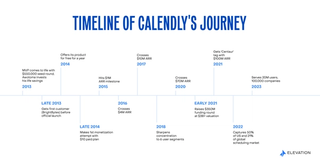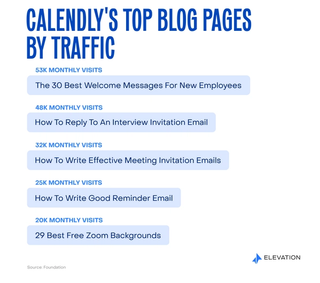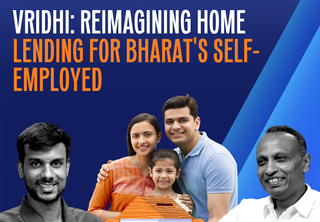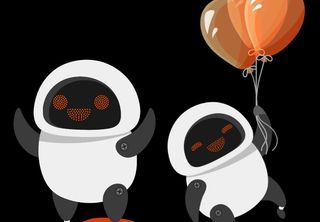Mastering Time: How Calendly Became A $3B Powerhouse With Product-Led Growth
Unpacking Calendly's SaaS PLG playbook for exponential growth
Picture this: You're a sales executive for a global SaaS company. What you thought would be a simple attempt to schedule a meeting with a prospective customer quickly descends into a flurry of back-and-forth emails, embarrassing double bookings, and time zone confusions. You don't have to imagine this. We've all been there. When Tope Awotona found himself in a situation like this a decade back, he found the spark for Calendly - a user-friendly scheduling tool that simplifies appointment bookings.
Calendly was born out of Awotona's efforts to save one of the most vital resources for professionals and enterprises - time. That mission, which began with Awotona's six-month research journey to simplify scheduling, is worth $3B+ today. The US-headquartered company today boasts over 20 million users and helps over 100,000 businesses plan meetings. Awotona cut his teeth in enterprise software sales for seven years, working with biggies like IBM and Dell EMC. Simultaneously, he found the time to launch three startups - an e-commerce store for projectors, a dating website, and a platform dedicated to home equipment sales - none of which took off.
Before Calendly came along, other scheduling services like Booking Live and Acuity Scheduling existed. However, they didn't catch on because they lacked a simple UX and integrations. Moreover, because these tools required payment, few professionals or companies were willing to spend money on such software back then. As a result, most people continued to schedule meetings through back-and-forth emails.

Calendly is not the first company, nor will it be the last, to successfully deploy a GTM strategy where a company's product itself serves as the primary driver for acquiring, converting, and retaining users. But Calendly stands out by ticking all the critical characteristics associated with Product-Led Growth, such as user-centric focus, self-service onboarding, freemium pricing model, viral and network effects, data-driven decision-making, customer success and upselling, and iterative development.
Remarkably, before its latest $350 million round in January 2021, Calendly had already scaled to $70M ARR on the back of just $550,000 of seed funding received in late 2013.
Through this article, we have attempted to decode how Calendly turned the world of scheduling on its head with PLG.
Calendly's Product and Revenue Model
Calendly streamlines the process of scheduling meetings for both individuals and organizations. By setting up a profile in just a few minutes, the host can outline preferences like time zone, availability, types of events and even customize the profile branding. This lets the invitee view all open slots in the host's calendar and select a suitable meeting time. Further enriching its functionality, Calendly integrates with various tools, including Zoom, Salesforce, Hubspot, Typeform, Notion, and Google Analytics. These integrations span numerous categories, such as email messaging, analytics, sales and CRM, and video conferencing. Some of the features of Calendly include customizable scheduling pages, auto-detection of time zones, calendar synchronization, group scheduling, buffer times between events, and automatic reminders.

Calendly operates a tiered pricing model with five plans to drive its revenue. The Basic plan is always free. The others are Essentials, starting at $8 per user per month; Professional, starting at $12 per user per month; Teams, starting at $16 per user per month; and Enterprise, intended for teams of 30 people or more. For those considering the paid versions, Calendly offers a 14-day free trial for each. It's worth noting that Calendly steered clear of the typical pricing structure based on the number of meetings scheduled, as it was considered punitive and harmful to user experience. Instead, Calendly used levers like event types, customizations, integrations, workflows, and business support to decide the pricing.
Send Me Your Calendly
Calendly's inception dates back to early 2013 when founder Awotona emptied his entire savings to initiate its development. To curb costs, he outsourced the building of the Minimum Viable Product (MVP) to a Ukrainian development agency. The company's first client, a data and analytics platform used by schools and colleges called BrightBytes, came on board even before the official product launch. Intrigued by a conversation with Awotona about his product, members of the Bay Area company became the first users of Calendly's MVP.
The first six months following the launch saw Calendly's user base reach a thousand customers. Despite this early success, the company allowed free usage of its product for more than a year. It was not until late 2014 that Calendly made its first attempt at monetization, introducing a $10 premium plan as an experiment. The team settled on this price point after much experimentation. This plan provided users with benefits like removing watermarks and timely reminders. By 2015, the premium plan was enhanced with more features, propelling Calendly's ARR to hit the $1M mark.
The company had a core product philosophy of quality over quantity, choosing to build for a specific user set rather than casting a wide net. This led them to concentrate on six user segments: sales, marketing, customer success, recruiting, IT, and education.
Calendly was successful in upselling paid plans to users on its free tier, which included all core features but came with usage restrictions. For instance, while free plan users could only connect one calendar and set up a single event type, the paid plan offered the ability to connect multiple calendars, customize meeting pages, establish workflows, access analytics, assign meetings in a round-robin style, and integrate with popular apps.
As word spread about Calendly's efficiency and simplicity, its adoption surged. The expression "Send Me Your Calendly" swiftly became synonymous with scheduling meetings. As of 2022, Calendly holds a commanding 53% share of the US scheduling market and a 21% share in the global market.
Breaking Down Calendly's Rapid Growth
Calendly's meteoric rise can be largely attributed to its strategic deployment and execution of product-led growth (PLG), initiated once a solid product-market fit (PMF) was established. The driving forces behind Calendly's PLG motion include:
- Built For Collaboration: Calendly is cleverly designed to foster collective participation organically, thereby delivering a dual advantage of enriching the user experience while boosting user growth.
- Perfecting The Product: Instead of leaning heavily on traditional sales or marketing-driven strategies, Calendly centered its business on the product itself. The company spent a great amount of time perfecting the product with the early user base, consciously resisting the urge to pursue monetization sooner.
- Well-defined Metrics: Calendly measures success by tracking the number of invites sent (K-factor), invitations accepted, and newly created accounts. These clear-cut metrics provide an exact view of their growth trajectory and areas needing improvement.
Calendly has successfully incorporated the principles of the Hooked model (a framework for designing habit-forming products conceptualized by renowned design thinker Nir Eyal) into its product development philosophy. This is evident in Calendly's user journey, which demonstrates how a viral loop is effectively implemented.

Calendly's journey from an idea to a multi-billion dollar unicorn yields valuable insights into effective product strategy, growth, and company building.
- Investing In Low-Cost Acquisition Channels: Calendly's reliance on non-paid marketing and advertising allowed it to maintain its Customer Acquisition Cost (CAC) close to zero.
- Indexing on Free Trials: Calendly banked on free trials for paid plans to help users understand and become accustomed to the product.
- Solving a Singular User Pain Point: Calendly selected a singular problem - simplifying meeting scheduling - and addressed it through a clean, intuitive user experience.
- Product-GTM Symbiosis: Selecting a GTM strategy that always aligns with the value the product is creating is crucial to sustainable growth.
In essence, Calendly's success story highlights the strength of a PLG strategy, the resilience of a robust brand, the significance of cost efficiency, customer focus, and superior product experience. These practical insights can guide other founders in charting their growth paths.
Are you building a SaaS business or have a groundbreaking idea? We at Elevation have a dedicated SaaS team eager to hear your vision. Connect with us at saas@elevationcapital.com
The viral nature of Calendly stems from a powerful mix of product-led growth, customer-centricity, and data-driven growth monitoring, all structured around a systematic user engagement cycle.
Evolution of Calendly's GTM Strategy
Calendly has been adept in aligning its go-to-market (GTM) strategy with its evolving product offerings and user base. As the company and its user base grew, so did its GTM strategy.
Initially, Calendly took a wholly self-service approach, with no dedicated sales or support teams in the early stages of the company. By catering to smaller, tech-savvy firms through this method, Calendly was able to grow its revenue to $4M.
Recognizing that individual users from mid to large-scale companies were beginning to use Calendly, the company moved towards a hybrid GTM strategy that combined the original self-serve sales approach with the addition of human-assisted sales. As explained by Awotona in an interview, "So we saw very quickly that, whenever people wanted to roll something out to a larger group, typically, they feel more confident when they can talk to a human being about doing that. A lot of times, the questions I answered for them were questions that were present on our website or our docs. But they wanted to talk to a human being.
This strategy eventually developed into a sales-assisted "land and expand" strategy, with the sales team reaching out to Calendly users and their departments to explain the additional benefits that come with paid plans.
The effectiveness of Calendly's online marketing also contributes significantly to its GTM strategy. Understanding that their ideal customer profile (ICP) had a significant presence on LinkedIn, where most lead generation and professional outreach took place, Calendly began to use the platform as an acquisition channel through well-curated content. As a result, they saw about 60% of their referral traffic coming from just LinkedIn.

Interestingly, Calendly does not allocate resources to paid advertising. Instead, a substantial portion of the traffic to their website originates from the informative and engaging content on the Calendly blog. With topics ranging from productivity, scheduling and meeting etiquette, sales, time management, and professional tips, the blog content aims to help users extract maximum value from Calendly. The traffic generated organically from these posts equates to an annual advertising cost savings of approximately $2.4M.

Lastly, Calendly's high domain authority (with 811M backlinks and 31M Dofollow links) results in over 50% of its traffic coming from direct searches. To put this into perspective, Calendly receives about a million monthly visitors on its website.
Lessons From Calendly
Related

Vridhi: Reimagining Home Lending For Bharat's Self-Employed
Ram Naresh Sunku, Co-founder, Vridhi Home Finance
11.12.2024

Investing in Plena Data
Automating manual accounting tasks and improving employee experience with robots
14.10.2021

Monetization Strategies That Work: Insights from Consumer Tech Founders
Insights on what works when it comes to monetizing consumer apps in India.
10.12.2024